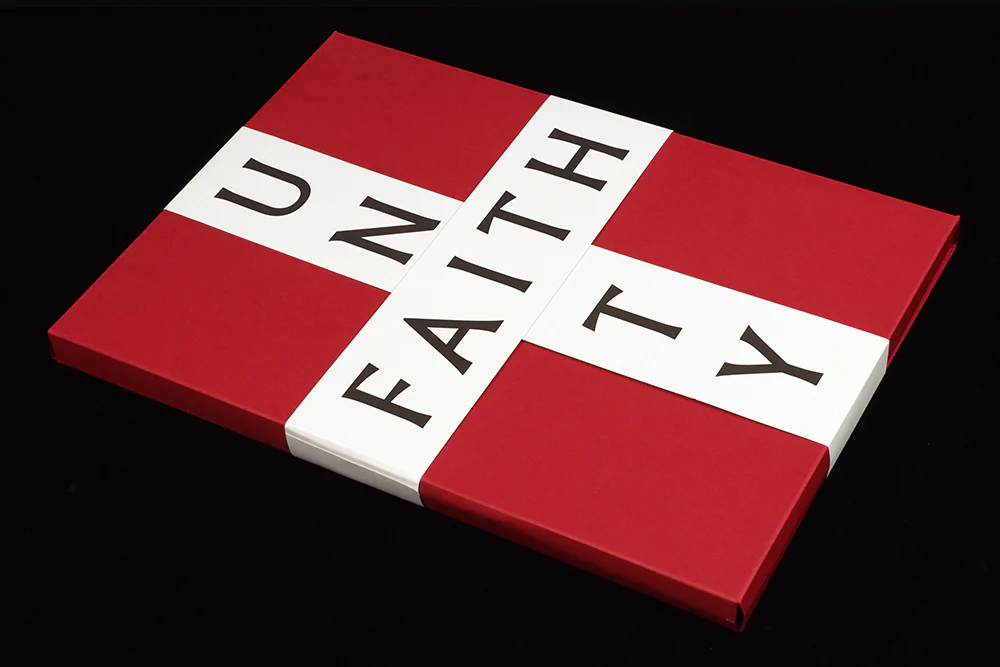
LAW #10
LAW is back, standing out again like an exclamation mark on our shelves (as we wrote back in 2016). This time, though, the context is very different.

The magazine has always used contrast to express an unheralded version of Englishness. Glossy full-bleed images celebrate this essential contrast throughout the issue. On the left (above), a sight so familiar from our high streets we ignore it daily: the discount hardware shop with its stacked plastic chairs and cheap extruded storage boxes spilling onto the pavement. The very essence of cheap mass production.
And on the right, a series of handmade spoons; an equally overlooked phenomenon, whittling spoons from pieces of wood is a traditional craft that continues up and down the UK, the polar opposite of mass production.


The issue continues in this tone across three seperately-bound A4 magazines, presented in a regal red folder bound by a pair of paper bands that spell out the ‘Unity and Faith’ theme. They cross to hint at the religious aspect of the theme, the letter ‘I’ neatly linking the two words.

A regular feature is the gridded set of nine items. Beer cans squashed flat by traffic (above) are presented in jewel-like richness (next to a photoshopped* joke about the joylessness of overwrought property-owners), while kids from a Hackney school band display the unaffected diverse happiness of modern education in school-portrait style imagery by Sam Wright (below).

The kids appear at the end of a profile of artist Jeremy Deller, someone who embodies everything LAW stands for—the continual evolution and cross-pollination of our everyday cultures rather then the locking down and deadening of tradition (It’s no surprise to find Scott King elsewhere in the issue too). The diagram above, Deller’s ‘The History of the World’, epitomises this, a flow diagram mapping the relationship between the English tradition of brass band music and more recent acid house music.
It’s a well-known piece but its presence here next to those school musicians extends the message further.

The opening spread of the Deller story highlights a key physical characteristic of the magazine. Headlines and texts appear on uncoated papers alongside images on high-gloss paper—simple but super effective throughtout all three mags.

Alongside these visual messages, tales of cultural history are told; John Simmons’s lifetime in menswear fashion retail is celebrated with an interview (above) that reminds us that specialist independent retail is nothing new.
Nothing about LAW is random; the two opening spreads shown above mix the headlines fonts: one a heavy industrial sans, the other a more subtle modernist serif in the style of Albertus (a font long used for identity of the super-wealthy and largely independent City of London).

Elsewhere we see images of football fans, ramblers, social club members, and phone masts disguised as trees. A fashion story adopts the visual language of English pagan festivals, and James Pearson-Howes’s portraits of East London muslims (above) are treated with as much respect as an update on rave culture by Ewen Spencer.
The magazine doesn’t make much of the broad range of people, culture and Englishness it celebrates within its pages; the images and texts are presented as a series of reports on the natural state of things in our country.
But that’s the key thing about the tenth issue of LAW. The team have refined and enhanced their message to produce a bigger, better issue than they’ve produced to date. Dedicated to founder John Jospeh Holt’s late brother Thomas Edward Holt, the issue is full of love for life.
As such it stands in stark contrast to so much of what passes for discussion of Englishness today. Where previously, perhaps, LAW was an interesting diversion, in today’s post-Brexit social media-soaked United Kingdom it gently—and rather Englishly—showcases what is great about the country.

There are two exceptions to this subtlety, and they clarify the magazine’s position. First, a series of placards the team produced for a BLM protest last summer (above), and second, the sign-off image from the issue—John Joseph Holt (below, righ) sits with his head buried in a St George’s flag.

This tenth issue of LAW is a big, bold piece of publishing that offers a quite unique take on today’s England. I love its message and the way the magazine format is used to express that message. For that reason it’s the first in our new series of Magazines of the Month.
*Since this piece was published we’ve learned that the sign was not created digitally, but ‘made, manufactured and put on a railing!’
Editor: John Jospeh Holt
Design and type: All Purpose


